OmegA
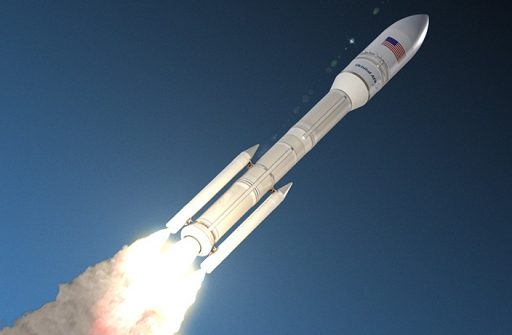
Omega, stylized as OmegA and formerly known as NGL, is an intermediate- and heavy-lift launch vehicle developed and operated by Orbital ATK for national security and commercial missions to all types of orbits. Born out of the defunct Ares I and Liberty Projects, Omega is to leverage Orbital ATK’s advanced solid rocket propulsion technologies in the boost stages while the role of upper stage is filled by a cryogenic stage capable of multi-burn and long-coast missions to allow Omega to access all orbital regimes.
Orbital ATK officially announced plans of what it at the time called the “Next Generation Launcher” (NGL) in May 2016, but the company had long been hinting at plans to develop a largely solid-fueled EELV (Evolved Expendable Launch Vehicle) replacement that could be competitive on the changing launch market while also being of use for government missions. The U.S. Air Force contributed seed money for the initial development effort as part of its search for EELV follow-on vehicles in an effort to end reliance on the Russian-built RD-180 engine of the Atlas V rocket.
Orbital ATK shared specifics on the rocket’s design in May 2017 and NGL was christened “OmegA” in April 2018.
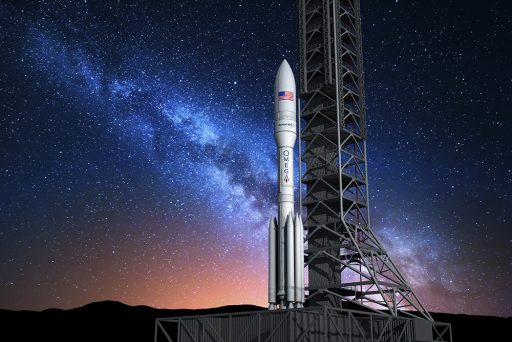
Omega can fly in a variety of configurations to be tailored to specific mission requirements, offering two different Core Stage sizes known as the Common Boost Segment which can be outfitted with up to six SRBs from Orbital ATK’s Graphite Epoxy Motor (GEM) line. The second stage is a single-segment Shuttle-derived solid motor while the third stage employs an advanced Cryogenic Upper Stage with a pair of upgraded Aerojet Rocketdyne RL-10C engines.
Omega is to be based at Florida’s Kennedy Space Center under the multi-user spaceport approach, utilizing present ground infrastructure including NASA’s Vehicle Assembly Building, Mobile Transporter and Launch Complex 39B that was converted to a ‘clean pad’ after retirement of the Space Shuttle so that it would be usable by different launch vehicles. Orbital ATK also said it was looking into bringing Omega to Vandenberg Air Force Base if demand for high-inclination launches exists.
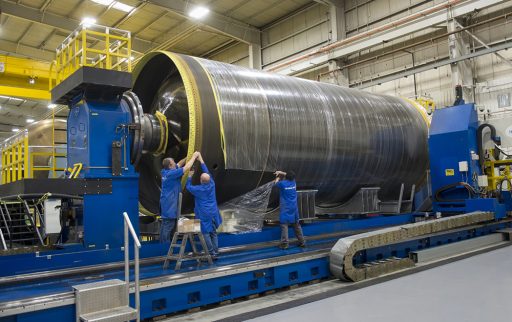
The intermediate version of Omega can haul up to 10,100 Kilograms into a Geostationary Transfer Orbit, enabling it to lift the heaviest commercial GEO satellites currently in operation and providing sufficient performance for Ariane 5-style dual-payload flights. The heavy configuration can lift up to 7,800 Kilograms directly into Geostationary Orbit – surpassing the performance of the Delta IV Heavy rocket which is mostly called up for launches of the heaviest reconnaissance satellites currently in operation by the U.S. Government.
These performance numbers would also make Omega useful for the Lunar Orbit Platform – Gateway (LOP-G), capable of lifting fully-loaded Cygnus spacecraft as part of a potential resupply architecture. Orbital ATK did not publish the Low Earth Orbit capacity of the Omega rocket, though that number should be in the neighborhood of 35 metric tons based on the vehicle’s characteristics.
Omega Design
| Type | OmegA (formerly NGL) |
| Launch Site | CCAFS, Vandenberg |
| Height | 59.84 m (Intermediate) |
| Diameter | 3.71 m |
| Launch Mass | 440-765 t (Intermediate), 715-1,040 t (Heavy)* |
| Stages | 3 |
| Boosters | GEM-63XL/T (0 to 6 SRBs) |
| Stage 1 | Castor 600 or Castor 1200 |
| Stage 2 | Castor 300 |
| Stage 3 | Cryogenic Stage (2 x RL-10C) |
| Mass to GTO | 4,900 – 10,100 kg (Intermediate) |
| Mass to GEO | 5,250 – 7,800 kg (Heavy) |
Orbital ATK’s Omega is a modular three-stage launch vehicle combining the raw power of solid motors for its boost stages with the high performance of a cryogenic upper stage with re-start and long-coast capability.
Per its modular design, Omega can be fitted with two different first stages: the Intermediate Configuration (also called Omega-500) employs a Castor 600 Solid Rocket Motor as first stage while the Heavy Configuration (Omega-500XL) has a Castor 1200 first stage that is twice the size of the intermediate version. The first stage can fly with up to six GEM-63XL/T Solid Rocket Boosters and odd-numbered booster configurations can be supported for maximum performance flexibility (like the Atlas V). A Castor 300 one-segment SRB-equivalent composite motor builds the second stage and the role of upper stage is filled by a dual-engine cryogenic stage sporting two RL-10C engines.
The Intermediate Configuration of Omega stands 59.84 meters tall and weighs between 440 and 765 metric tons, depending on the number of boosters installed around the core stage.
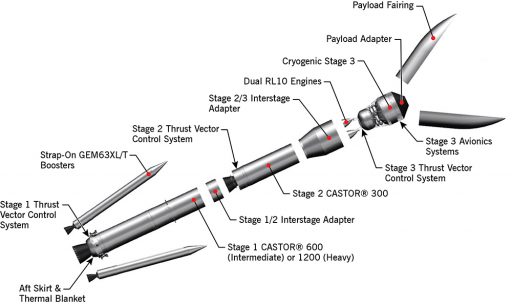
Omega Heavy is around 80 meters long and has a launch mass between 715 and 1,040 metric tons. Rough estimates for Omega’s total launch thrust are 6.7 to 18.7 Meganewton for the Intermediate Configuration and 13 to 25 MN for the Heavy.
The capability of combining two different first stages with a flexible number of boosters allows Omega to be tailored very specifically to a mission’s specific performance requirements while also keeping the total number of different launch vehicle components limited. The combination of solid-fueled stages with a cryogenic upper stage takes advantage of the high thrust of solid motors getting off the ground while the high impulse of the LOX/LH2 propellant combination provides the upper stage with high performance.
Omega Development
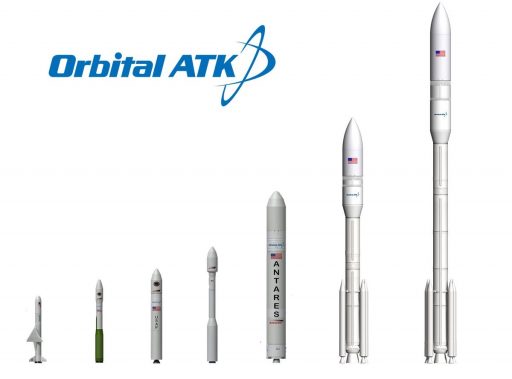
Orbital ATK has extensive experience with solid-fueled propulsion systems, having provided the reusable Solid Rocket Boosters for the Space Shuttle over its thirty-year career, supplying boosters for various U.S. Rockets including the Delta II and Delta IV, and operating its own fleet of mainly solid-fueled launch vehicles. Antares – employing a liquid-fueled boost stage – represents the large exception and required Orbital to look for liquid propulsion expertise elsewhere (procuring the stage structure & tanks from the Ukraine and using Russian-built engines).
While the Pegasus & Minotaur product lines covered the light-lift sector and Antares could be used for medium-lift missions, Orbital ATK always lacked an intermediate- or heavy-lift solution capable of competing in this sector of the market.
Before merging with Orbital, Alliant Techsystems was involved with NASA in the development of the launch vehicles of the Constellation Program initiated in 2005 to set NASA’s to human exploration of targets Beyond Earth Orbit (BEO).
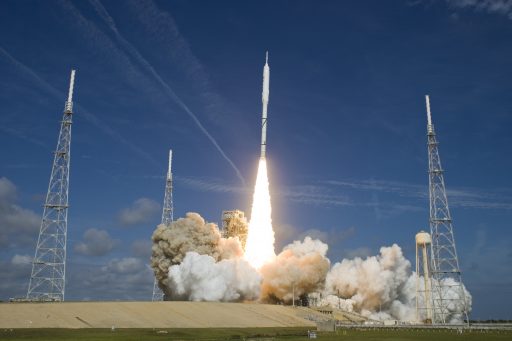
Ares I was picked as the program’s crew launch vehicle, comprising a Shuttle-derived five-segment Solid Rocket Booster as first stage and a J-2X-powered cryogenic second stage. ATK’s five-segment SRBs were also to be used for the Ares V super-heavy lift launch vehicle to deliver the deep space habitat, lander and Earth-departure hardware.
The Ares V design and with that ATK’s five-segment boosters continued after the 2009 cancelation of Constellation in NASA’s Space Launch System which aims for its first test launch in 2020. Since the bulk of development work on the five-segment motor had already been completed under constellation and further qualification work was planned under SLS, ATK was actively shopping the system as a propulsion solution for a potential commercial launch vehicle (which could benefit from qualification work performed under NASA contract while NASA could benefit from lower production cost if the booster could be serial produced for a number of missions per year).
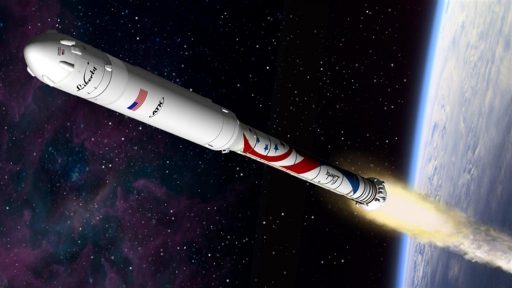
ATK found open ears at Europe’s Astrium and the result was Liberty, a two-stage solid-liquid rocket powered by a five-segment SRB as its first stage and an Ariane 5 Core Stage in the role of second stage. With a Low Earth Orbit capacity of 20 metric tons, the vehicle was submitted as a contender in NASA’s Commercial Crew Development Program in 2011. However, NASA did not select the proposal but offered to support continued development through a non-funded Space Act Agreement.
By the 2012 Commercial Crew Integrated Capability (CCiCap) selection, ATK and Astrium had polished up their proposal to be a complete transportation system including the launch vehicle and crew transportation system with spacecraft, abort capability and ground operations (using a crew vehicle largely based on Orion). However, NASA did not select the proposal and ATK eventually conceded and stated the company was “moving on.”
The merger of Orbital Sciences and ATK was seen as the creation of a new level of technical capabilities and synergies that could strengthen further launch vehicle development efforts. The United States Air Force awarded Orbital ATK with $46.9 million of funding, to be matched by $31.1 million from the company, to continue development of the Next Generation Launcher as one of the contenders to solve the Air Force’s most critical problem: dependency on the Russian-built RD-180 engine powering the Atlas V rocket. The contract had options up to $180.2 million to be matched with up to $124.8 million in company funds.
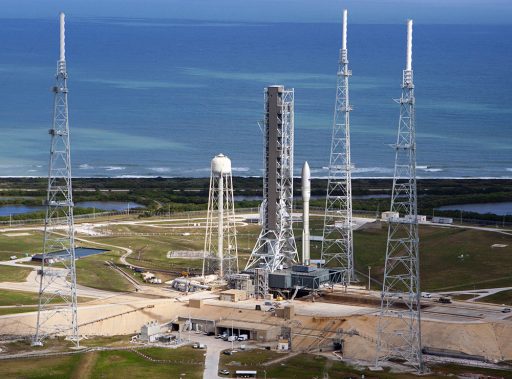
At the time, Orbital ATK’s NGL proposal called for a large solid-fueled core stage substituting the Shuttle-era metal SRB cases with composite materials, clustering a flexible number of boosters around the core and placing a smaller solid rocket motor as second stage and employing a cryogenic upper stage powered by Blue Origin’s BE-3U engine. A previous R&D effort, funded by NASA, had demonstrated that composite solid rocket motor cases on the scale of the Shuttle SRB would be a feasible means for mass and cost reduction.
Press reports detailing Orbital ATKs development effort began emerging in January 2016 and the first depiction of the company’s NGL proposal was seen in Air Force documentation in March of that year. The company officially unveiled NGL in May 2016 when laying out its business case of creating a vehicle for the whole spectrum of GTO and GEO launches while keeping costs down through the use of the company’s existing product lines, existing liquid propulsion solutions for the third stage and existing launch infrastructure at the Kennedy Space Center and Vandenberg Air Force Base.
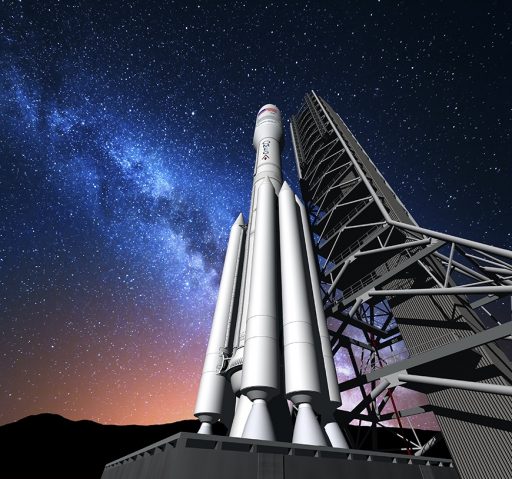
When working on Liberty, the company had already expressed interest in leasing High Bay 2 of the Vehicle Assembly Building at the Kennedy Space Center and re-purposing Mobile Launch Platform 3. Orbital ATK said the new rocket’s primary launch site would be the Kennedy Space Center, although development pace and introduction into service would largely depend on customer demand and funding from the Air Force.
In April 2017, Orbital ATK presented in-depth details on the NGL with specifics on the Castor-based core stages and the GEM boosters. However, the company still kept their options open with regard to the rocket’s upper stage. The company also confirmed Launch Complex 39B at KSC as the rocket’s primary launch site and that the Mobile Transporter would be shared with the Space Launch System as both systems were looking at a limited number of missions per year.
In April 2018, Orbital ATK announced it had selected Aerojet Rocketdyne’s RL-10C engine over Blue Origin’s BE-3U for the rocket’s upper stage. NGL was also re-named “OmegA” representing the book-end of the company’s rocket lineup from the small-class Pegasus and Minotaur, over the medium-class Antares and now to the large-class OmegA.
According to the company, the use of common subsystems and existing hardware is expected to save around $600 million over ten years of development. As of 2018, around 500 employees were working on Omega and Orbital ATK expected that number to double by 2020 in support of a test flight in 2021.
Common Boost Segment – Castor 600 / 1200
| Type | Castor 600 / Castor 1200 |
| Diameter | 3.71 m |
| Length | ~23 m / ~37.5 m* |
| Motor Case | Carbon Composite, Epoxy |
| Propellant | Solid – QEY (?), HTPB, 19% Aluminum |
| Launch Mass | 272 t / 545 t* |
| Propellant Mass | 252 t / 504 t* |
| Average Thrust | 6,660 kN / 9,996 kN** |
| Specific Impulse | 276 sec / 268 sec** |
| Burn Time | 114 sec / 133 sec** |
| Control | Thrust Vector Control |
| *Estimated; **Illustrative Figures for RSRM Equivalent | |
Omega can be fitted with two different first stages, Orbital ATK’s Castor 600 powers the Intermediate Configuration while the Heavy relies on Castor 1200 that is twice the size than the baseline motor. Both elements are referred to as the Common Boost Segment.
These two are the largest members of the company’s Castor product line and essentially represent Space Shuttle-derived Solid Rocket Boosters with the major difference being them using a composite motor case instead of the steel cases used by the Reusable Solid Rocket Motor (RSRM) flown by the Shuttle.
ATK’s Castor family started out in 1959 to support NASA’s Scout and Little Joe launch vehicles. Since then, the Castor family was expanded considerably and underwent a number of performance enhancements, including the switch from metal to composite motors.
Castor motors have flown as a strap-on booster for the Delta II rocket, served as first stage for the Athena and Taurus/Minotaur-C rockets and supported Orbital’s Antares rocket as an upper stage. The addition of the Castor 300, 600 and 1200 motors expands the family to support heavy-lift capabilities by means of new types of composite motors at unprecedented scale.
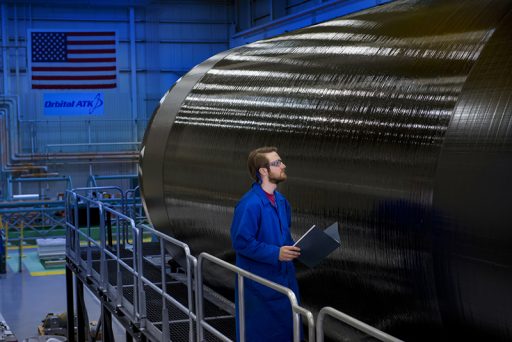
The core goal behind the introduction of the heavy-duty Castors was moving from heavy steel motor cases as used on the Space Shuttle to lightweight carbon composite materials to increase performance and lower manufacturing costs. Performance gain achievable with composites becomes evident by looking at the propellant mass fractions of the different motors: the Shuttle-era RSRM had a propellant mass fraction of 0.844; modern-day RSRM equivalents (also four segment) are slightly more efficient at 0.872 while Orbital ATK’s composite motors achieve propellant mass fractions in the range of 0.92 to 0.945.
Castor 600/1200 are the composite-equivalent to the two- and four-segment RSRM motors, replacing the D6AC steel cases with a carbon composite wound case while the propellant formulation switched from the PBAN binder used on the Shuttle to HTPB (Hydroxyl-terminated polybutadiene) that has proven very efficient on the GEM motor line. Though PBAN offers a slightly higher performance, HTPB is generally preferred since it has a faster curing time and is easier to manage during manufacture.
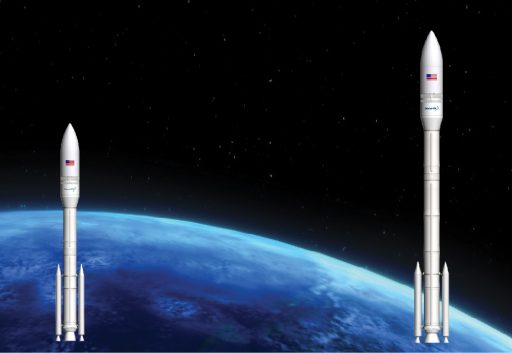
Castor 600 has a launch mass of approximately 272 metric tons and matches the Shuttle SRB’s diameter of 3.71 meters. The two-segment RSRM is 21.84 meters long and loaded with around 252 metric tons of propellant, generating an average thrust of 6,660 Kilonewtons over a 114-second burn time. The baseline RSRM nozzle has a 3.01-meter exit diameter and possesses a 10.4 area ratio.
The Castor 1200 motor weighs in at around 545 metric tons and stands ~37.5 meters tall, holding around 504 metric tons of propellant. A four-segment RSRM was to generate an average thrust of 10,000 Kilonewtons, peaking at 13 MN for the first 20 seconds of the 133-second burn time – performance for Castor 1200 is likely similar.
Orbital ATK has not yet provided detailed performance information for the new Castor motors, likely becoming available after initial static fire testing is conducted.
Boosters – GEM-63XL/T
| Type | GEM-63 XL/T |
| No. of Boosters | 0 to 6 |
| Diameter | 1.60 m |
| Length | 21.95 m |
| Motor Case | Carbon Composite, Epoxy |
| Propellant | Solid – QEY, HTPB, 19% Aluminum |
| Launch Mass | 53,400 kg |
| Propellant Mass | 48,000 kg |
| Average Thrust | 2,000 kN |
| Specific Impulse | |
| Burn Time | |
| Nozzle Diameter | 1.42 m |
| Control | Thrust Vector Control (Optional) |
Omega can fly with any number of boosters between zero and six, including unsymmetrical booster configurations with an odd number of SRBs. The booster chosen for the Omega rocket is the GEM-63XL/T as the newest addition to Orbital ATK’s line of Graphite Epoxy Motors (GEM). The GEM product line has been employing epoxy composite casings from its very beginning, making for low dry mass of the boosters to maximize performance.
The GEM product line started out with the GEM-40 (40-inch diameter) SRB developed to increase the launch capability of the Delta II rocket. Over the years, the GEM line was expanded and established itself as a reliable and low-cost booster option for launch vehicles. Different variants of the GEM-40 included ground- and air-start SRBs, canted fixed nozzle and vectorable nozzle designs. GEM-46, a taller and wider version, was developed to support the Delta II Heavy configuration.
The GEM-60, a third-generation booster, was developed for commercial application on the Delta IV rocket and is also available with a canted fixed nozzle or a vectorable nozzle configuration. Another step toward larger and more-powerful SRBs is the GEM-63 that further broadens the SRB’s diameter by three inches and stretches its length to hold more propellant.
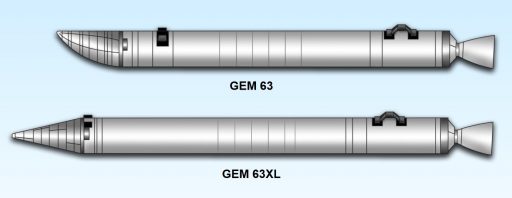
The GEM motor cases are filament wound by computer- controlled winding machines, employing high-strength graphite fiber and durable epoxy resin to create a very strong case capable of withstanding increased chamber pressures. Propellant mixing and motor casting processes also rely on computerized and robotic facilities to achieve a consistent and repeatable performance. The use of largely automated processes also lowers cost and makes the GEM line one of the most competitive products on the U.S. market.
GEM-63 and GEM-63XL were being developed concurrently as a next-generation SRB for intermediate and large-class space launch vehicles – capitalizing on existing GEM designs and materials plus lessons learned from previous booster developments to keep costs at a minimum. Per its development program, GEM-63 was to undergo full-scale static testing and qualification in mid-2018.
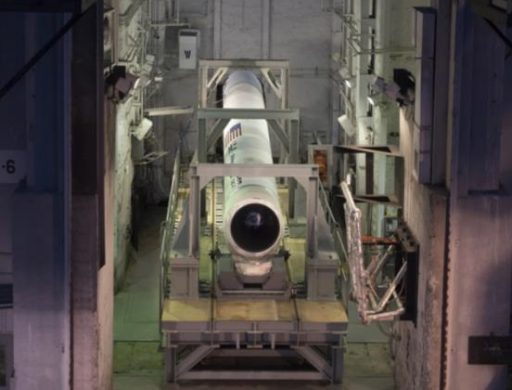
The GEM-63 motor is being developed as a drop-in replacement for the Aerojet Rocketdyne AJ60A booster on the Atlas V since it offers higher performance at almost half the cost. As such, GEM-63 retains the inward slanting nosecone of the AJ60A as used on Atlas to avoid the need for an aerodynamic re-design of the vehicle late in its operational life.
GEM-63XL is being developed for use on ULA’s upcoming Vulcan rocket and Orbital’s Omega, switching to a conventional nosecone design which will enable separation in a wider aerodynamic range than the inward slanting option. GEM-63 uses a typical HTPB-bound solid propellant configuration.
The standard GEM-63 Solid Rocket Booster is 1.6 meters in diameter and 20.09 long with a dry mass of 5,100 Kilograms and a propellant capacity of 44,200 Kilograms. The XL version has an extended motor case and stands 21.95 meters tall, capable of holding 48,000 Kilograms of propellant to deliver a thrust of 2,000 Kilonewtons. Exact performance parameters are expected to be provided after qualification testing of the two booster variants.
Second Stage – Castor 300
| Type | Castor 300 |
| Diameter | 3.71 m |
| Length | ~13 m |
| Motor Case | Carbon Composite, Epoxy |
| Propellant | Solid – QEY (?), HTPB, 19% Aluminum |
| Launch Mass | 136 t* |
| Propellant Mass | 126 t* |
| Average Thrust | 3,572 kN** |
| Specific Impulse | 277 sec** |
| Burn Time | 116 sec** |
| Control | Thrust Vector Control |
The second stage, a Castor 300 single-segment SRB equivalent, is common for all Omega configurations. As with the larger Castor 600/1200, it differs from the Shuttle-derived RSRM in that it substitutes the steel motor casing with a carbon composite material and switches to HTPB-bound solid propellant while keeping the overall dimensions of the original design.
Based on a one-segment RSRM, the motor weighs around 136 metric tons with a propellant capacity of approximately 126 metric tons, measuring 3.71 meters in diameter and standing around 12.7 meters tall. The one-segment RSRM is baselined for an average thrust of 3,572 Kilonewtons, peaking at 4,000kN in the first twenty second of the 115.8-second burn.
*Estimated; **Illustrative Figures for RSRM Equivalent
Third Stage
| Type | Cryogenic Upper Stage |
| Diameter | 5.25 m |
| Length | ~11 m* |
| Propellant | Liquid Hydrogen |
| Oxidizer | Liquid Oxygen |
| Propulsion | 2 x RL-10C-5-1 |
| Thrust | 101.8kN |
| Isp Vac | 449.7s |
| Engine Length | 2.18m |
| Engine Diameter | 1.45m |
| Engine Dry Weight | 190kg |
| Chamber Pressure | 24bar |
| Thrust to Weight | 57 |
| Area Ratio | 130 |
| Mixture Ratio | 5.5:1 |
| Burn Time | Variable |
| Engine Start | Restartable |
The third stage of all Omega variants is a re-startable, cryogenic rocket stage using Liquid Oxygen and Liquid Hydrogen propellants. Orbital ATK, as of April 2018, did not state whether it was manufacturing the stage in-house or whether it would be procured from another manufacturer.
From its appearance, the 5.25-meter diameter third stage resembles the Delta Cryogenic Second Stage featuring a five-meter Liquid Hydrogen tank sitting above the LOX tank with reduced diameter and connected through a lattice structure. Orbital ATK announced in April 2018 that the Omega third stage would be powered by a pair of RL-10C-5-1 engines of Aerojet Rocketdyne – an upgraded variant of the RL-10C introduced in 2014 employing a 3D printed engine injector assembly to reduce production cost.
The engine builds on the heritage of the RL-10 engine family that can look back at a history of several decades having completed its first test in 1959 after being developed by Pratt & Whitney. Over the years, the engine underwent a number of modifications, going through several generations and being used on different launch vehicles. The RL-10A versions of the engine were used by the trusted Centaur Upper Stage, most recently in the RL-10A-4-2 variant while previous RL-10A versions were also in use aboard the Saturn I and DC-X vehicles. RL-10B-2 is used on the Delta Cryogenic Upper Stage fitted on all launchers of the Delta IV rocket family.
Overall, RL-10C delivers a vacuum thrust of 101.8 Kilonewtons, slightly more than the RL-10A-4-2 and a little less than the RL-10B-2 with its huge nozzle. The engine achieves a specific impulse of 449.7 seconds. RL-10C measures 1.45 meters in diameter and 2.22 meters in length with a total mass of 190 Kilograms. The nozzle of the RL-10C creates an expansion ratio of 130 and the engine operates at a chamber pressure of 24 bar.
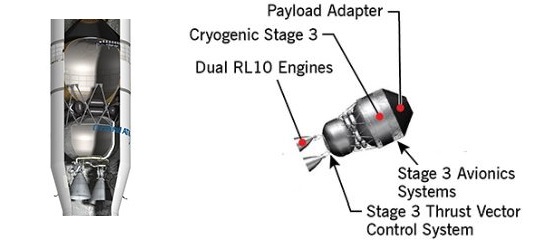
RL-10 Engine
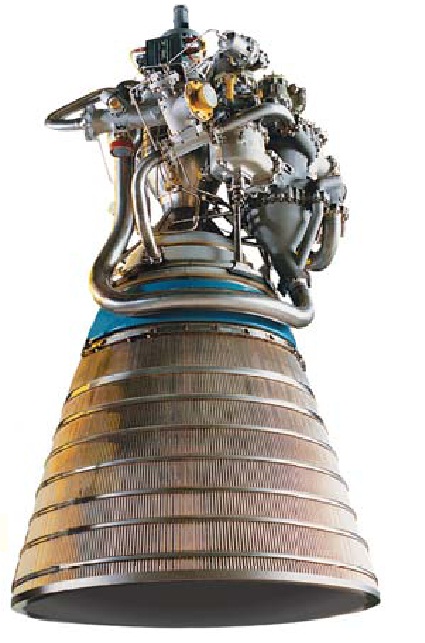
RL-10 is a closed Expander Cycle Engine which does not rely on a gas generator to deliver the hot gas that drives the turbopump turbines of the engine. Instead, the turbines are driven by expanded hydrogen gas that is generated by running the flow of Liquid Hydrogen from the LH2 turbopump through the regenerative cooling system of the upper nozzle segment and the combustion chamber. The gasified Hydrogen then passes to the main turbine of the engine, spinning the LH2 turbopump as well as the LOX turbopump through a gearbox.
Rl-10 includes seven engine valves starting on the fuel side with the Fuel Pump Inlet Shutoff Valve and on the oxidizer side with the Oxidizer Pump Inlet Shutoff Valve. Fuel flow into the combustion chamber can be stopped by the Fuel Shutoff Valve that is located just upstream of the combustion chamber injector.
This valve is used to rapidly cut the fuel feed to the engine for shutdown and its closure also allows the chilldown of the LH2 turbopump through overboard vents without any fuel entering the chamber. Engine LH2 pump chilldown is accomplished by opening Fuel-Cool-Down Valves 1 & 2 that vent coolant overboard during chilldown. These two valves also provide fuel pump bleed during pre-start and pressure relief during shutdown.
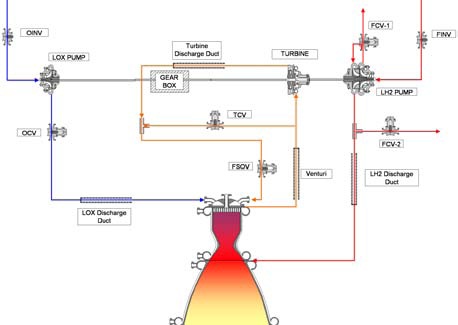
Thrust of the engine is controlled by a Thrust Control Valve located in a bridge between the fuel cooling outlet on the engine and the combustion chamber fuel inlet to bypass the turbine and thus regulate turbine power and overall engine thrust. Normally in a closed position, the system is mainly used to control thrust overshoot during engine start and to maintain a constant chamber pressure during steady state operation.
In the oxidizer line downstream of the pump is a Oxidizer Flow Control Valve that is used to regulate the LOX flow to the chamber for the regulation of the mixture ratio that is commanded by the Propellant Utilization Unit of the engine which controls the MR for an optimized propellant consumption. A second OCV is employed to regulate the bleed flow during engine start.
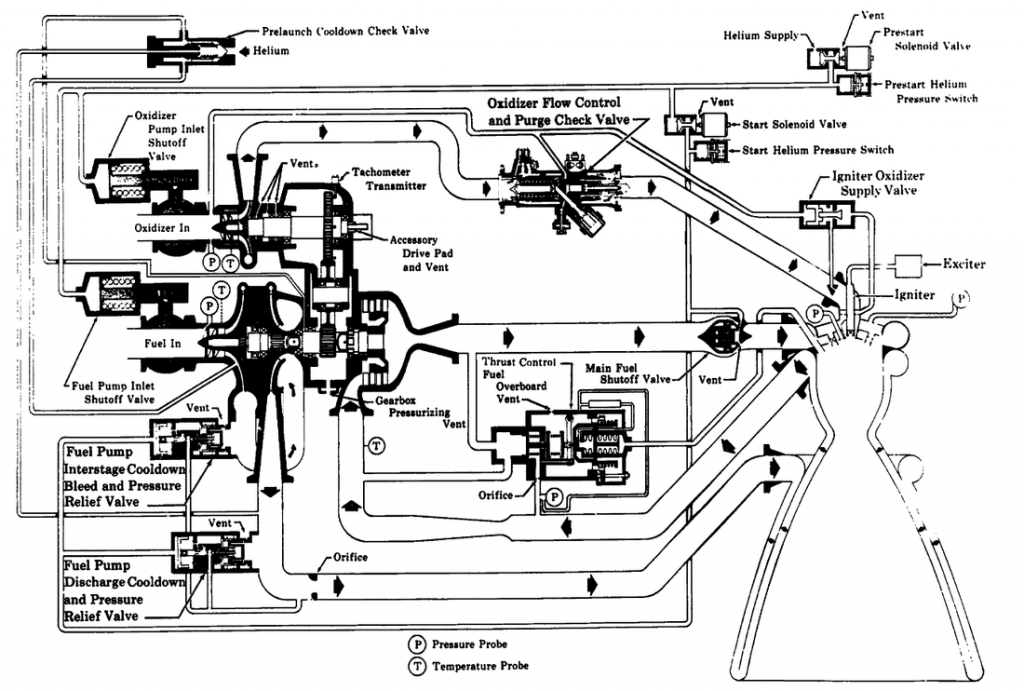
Engine start on the RL-10 is accomplished by using the pressure differential between the fuel feed and the near-vacuum in the chamber that forces fuel through the system after the Fuel Shutoff Valve is opened and FCV-1 is closed.
FCV-2 remains in an open position to prevent stalling the LH2 pump of the engine in start-up. In the initial stages of start-up, heat from the ambient metal is sufficient to generate Hydrogen gas to start driving the turbopumps and initiate the combustion process in the chamber, heating up the chamber and nozzle to operational levels. For start, the Oxidizer Control Valve is partially closed to ensure a fuel-rich ignition, limiting chamber pressure in order to maintain a pressure differential in the fuel system until the turbopumps can accelerate.
When the pumps are at flight speed, pneumatic pressure is used to close the Fuel Cooldown Valve and open the Oxidizer Control Valve to achieve the planned LOX pump discharge properties.
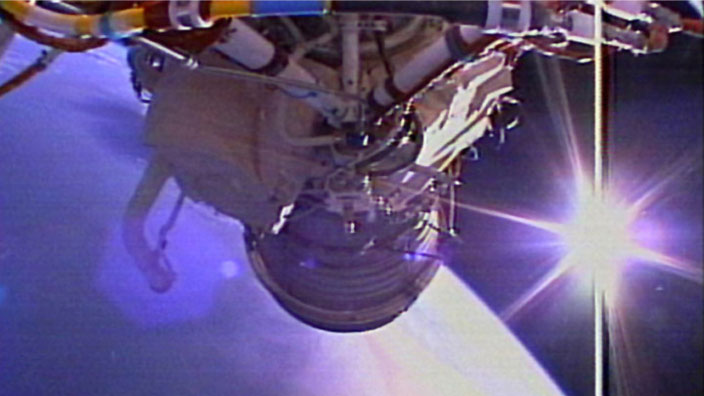
The opening of the OCV leads to a sharp increase in chamber pressure that can lead to thrust overshoot which is prevented by a temporary opening of the Thrust Control Valve until stable steady-state conditions are reached for engine operation.
In steady state operation, RL-10 consumes 20.6 Kilograms of LOX per second while LH2 flow is approximately 3.5 Kilograms per second.
Engine shutdown is a simple process accomplished by closing the Fuel Shutoff and Fuel Inlet Valve and at the same time opening the Fuel Control Valves to bleed fuel from the system. Oxidizer flow is cut by closing the Oxidizer Control Valve and LOX Inlet Valve. Friction losses lead to the spin-down of the turbines and pumps.
Payload Fairing
Omega can fly with two different fairing versions, both five meters in diameter which has become standard across the industry. The Intermediate Version of Omega will fly with a 15-meter long fairing while the Heavy version can be either fitted with the 15-meter fairing and an extended version offering another five meters of payload envelope height.
